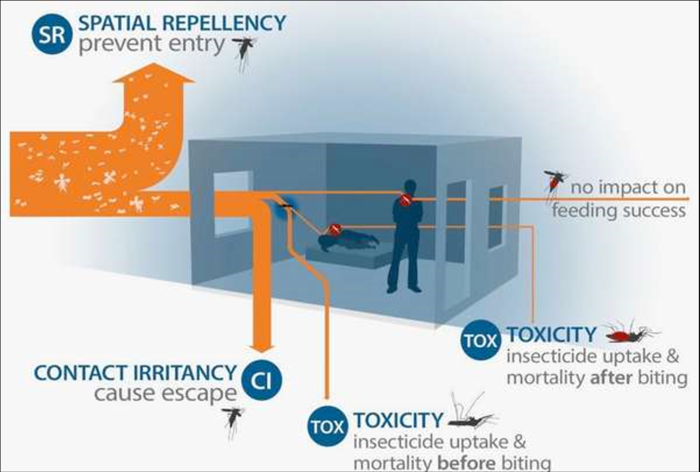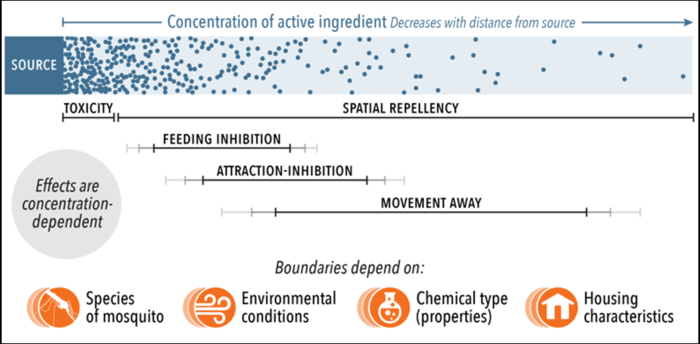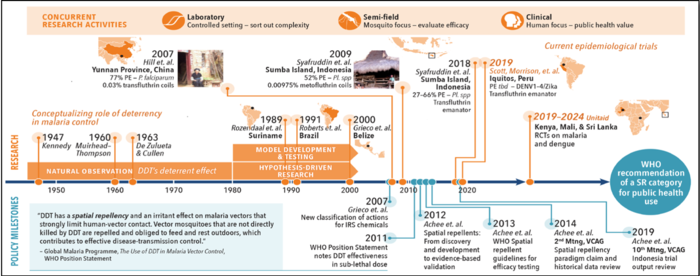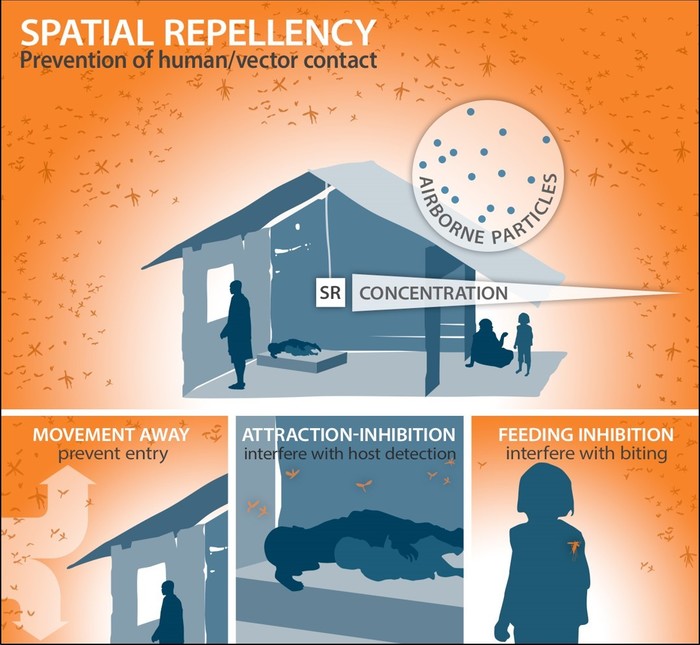Spatial Repellents
What are spatial repellents and how do they work?
Spatial repellent are chemical products designed to be 'active' (requiring heat or electricity) or 'passive' (requiring no heat or electricity) and release volatile chemicals into the air within the treated space. Product examples that are currently available include mosquito coils, candles among others; however, many more types of spatial repellent products are waiting to be developed.
Spatial repellents elicit ‘spatial repellency’ which refers to a range of insect behaviors induced by airborne chemicals that result in a reduction in human-mosquito contact. These behaviors include:
- movement away from a chemical stimulus,
- attraction-inhibition and/or,
- feeding inhibition

How are spatial repellents different than other chemical products such as toxicants and contact irritants?
In the most simplistic forms, repellents drive mosquitoes away from a treated space, toxicants kill mosquitoes and contact irritants cause agitation. Repellents can operate from a further distance than irritants and toxicants which rely on contact between the mosquito and a treated surface to function.
Many compounds exhibit two or more modes of action, but they can be distinguished by the concentration or dose needed to achieve them. Spatial repellency occurs at low vapor phase concentration, contact irritancy requires higher doses and killing requires absorption of still higher levels.

What is the role of spatial repellents in vector-borne diseases control and elimination?
Malaria, dengue and other mosquito-borne diseases are public health problems in many parts of the world. Malaria control strategies that have demonstrated success include treatment of infected individuals with drugs, application of insecticide to reduce mosquito populations through indoor residual spray, and reduction of human contact with infected mosquitoes via long-lasting insecticidal nets. Dengue prevention currently relies entirely on vector control and is focused on routine larval source management and reactive space spray or other adult-focused campaigns.
As goals of malaria elimination and eradication are put forth and the scope of dengue continues to grow, new tools will be needed to compliment the limited number of available interventions and/or further optimization of current products will be required to meet public health demands. The need for spatial repellents for vector control can be highlighted as they demonstrate effect against outdoor/day/early-evening biting mosquitoes – areas of transmission where traditional interventions are not completely effective. Spatial repellents have shown effect against insecticide resistant populations and may also have added benefit in areas where traditional long-lasting insecticidal nets or indoor residual spray interventions may not offer full protection or have reached their efficacy limits – especially in areas with residual transmission or in areas where elimination is considered.
Control of disease in these areas will require new approaches and may be where spatial repellency would be most effective. Spatial repellents may be offered as stand-alone tools where no other interventions are currently in use; or, most likely, combined with existing interventions to augment efficacy of these other tools (i.e., combination strategies).
History of Spatial Repellents
Since the 1950's, various studies have been conducted to discover, evaluate and demonstrate the impact of spatial repellents on mosquito behavior and human health:
- Reduction of mosquito entry into houses;
- Screening of candidate compounds and product platforms;
- Decrease in malaria infections of spatial repellent users.
The most successful malaria control chemical to date that exhibits spatial repellency is DDT. Vector mosquitoes that are not directly killed by DDT are repelled and obliged to feed and rest outdoors, which contributes to effective disease-transmission control (World Health Organization, 2011).

The Spatial Repellent Paradigm
Spatial repellents represent a new paradigm for vector control as they are designed to cause movement away from a location where humans are, cause attration inhibition and/or inhibit feeding on people. The goal of any of these responses is a reduction of mosquito-human contact to reduce pathogen transfer and resulting disease. This is different than traditional chemical uses which is intended to kill mosquitoes.
Spatial repellents may be offered as stand-alone tools where no other interventions are implemented, or most likely, combined with existing interventions to enhance efficacy of other mosquito control strategies. When used with other interventions, repellents may manage the spread of insecticide resistance and intervene in areas of the mosquito’s life cycle where other products do not reach.

Currently, there are 15 chemicals recommended by the World Health Organization for adult mosquito control representing only four chemical classes. The global community continues to place expectations of population-level protection using these very same, limited groups of actives in the same way on walls of houses and bed nets as that of the last 20years. Although this limited number of chemicals and application methods has contributed to decreasing malaria and dengue burden, they are becoming inadequate to sustain reductions in disease burden in many endemic countries. This is due, in part, to an overreliance on pyrethroids (which dominate the WHO shortlist of approved AIs) in both public health and agriculture and a resultant increasing occurrence of insecticide resistance, coupled with variable and poorly understood ecologies of different vector species.
The development of new products, and delivery strategies is needed. Although current global adult mosquito control strategies such as insecticide-treated bed nets, indoor residual spraying for malaria and space-spraying for dengue can be effective under certain circumstances these are limited in combating the transmission of pathogens in all areas where the diseases occur. Interventions must be adaptable according to the behavior of the mosquitoes that are being targeted (biting inside or outside the houses, at daytime or at night).
Data from the current program is intended to be used by global, regional and local public health authorities for consideration in the development of a recommendation that spatial repellents be included in disease control programs, thereby improving the quality of life in at-risk human populations.